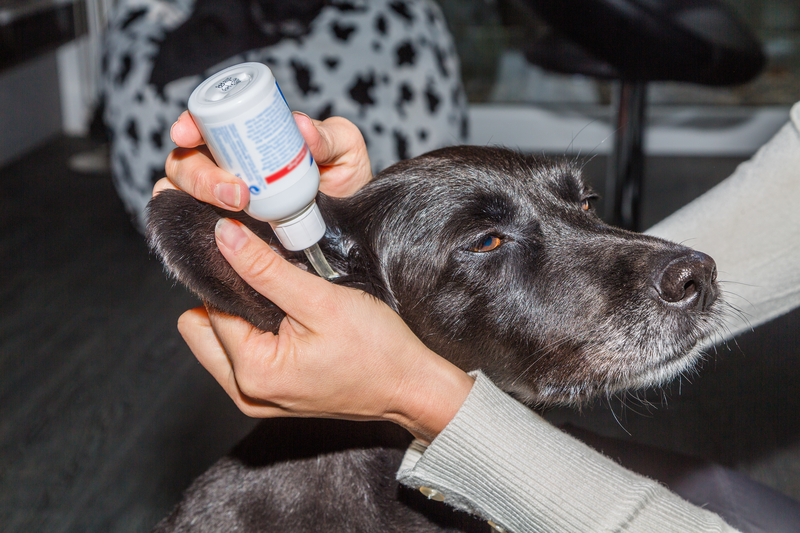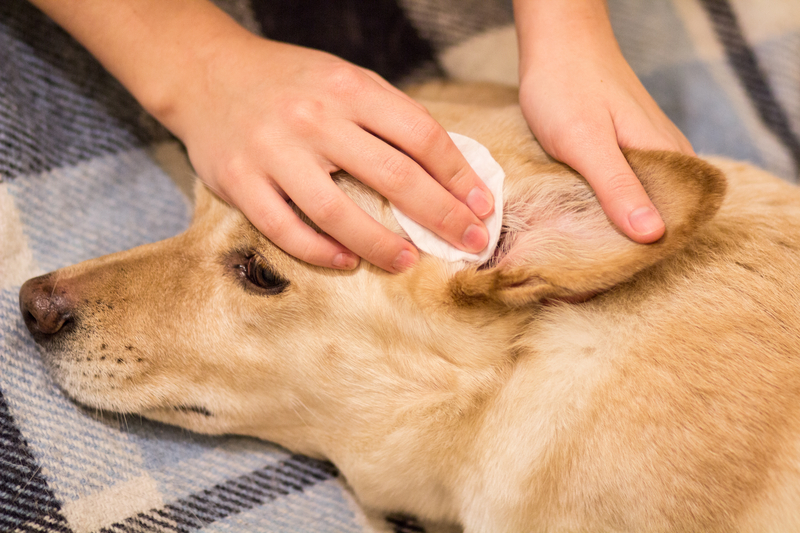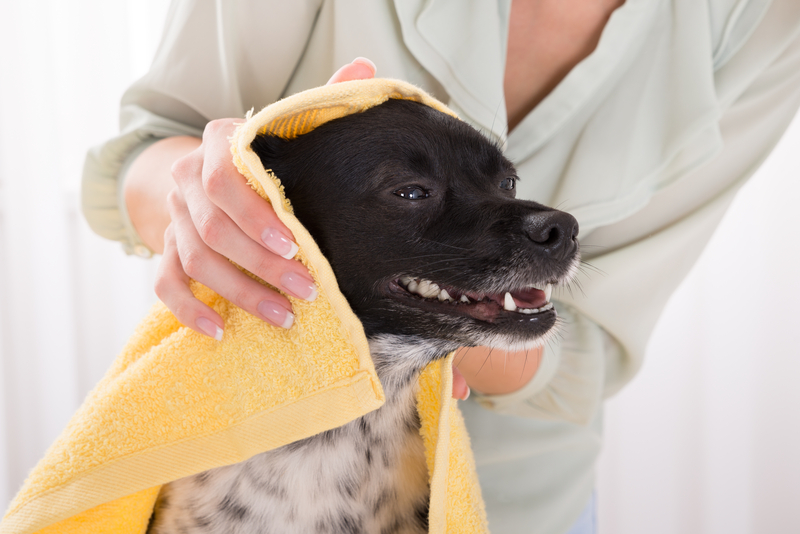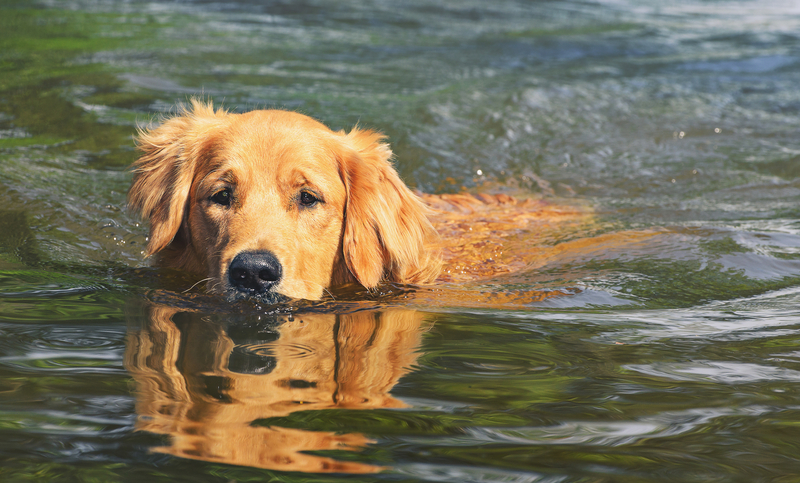How to Clean Your Dog’s Ears at Home
Posted: 11/22/2022 | BY: Erin Cain | Categories: Dog , Ear infection , Pet care
Keeping your dog’s ears clean is integral to their care. Still, it can be challenging if they are fussy about it or you feel uncomfortable doing it. Plus, it’s much cheaper than taking them to the vet for a professional cleaning! Here’s a step-by-step guide on how to clean your dog’s ears at home and why you should do it.

What are the symptoms of dog ear problems?
By caring for your dog’s ears regularly, you will be more aware of any changes in your dog’s behavior that could be signs of an ear problem. For example, suppose your dog is generally good with having their ears handled but suddenly yelps and pulls away. In that case, they may have an infection and be in pain.
The following symptoms accompany ear infections in dogs:
- strong, yeasty odor
- scratching at the ears
- discharge
- shaking the head repeatedly
- excessive dirt and debris in the ear
- rubbing the ears along the furniture or floor
Ear infections are common in some breeds and dogs with underlying health conditions. Nearly 50% of dogs with environmental allergies develop ear infections, and 80% of dogs with food allergies are likely to experience ear problems.
How do you know when to clean your dog’s ears?
The easiest way to determine when to clean your dog’s ears at home would be to check them regularly. Ears that are odor-free, pink, clean of dirt and debris, and show no sign of inflammation are healthy. If you notice any odor, discharge, or shaking of the head more than usual, then it’s likely that your pup’s ears need cleaning.
With the right tools and knowledge, you can keep your dog from getting ear infections by cleaning their ears regularly at home. It will save you money and spare your pup the discomfort and pain of an ear infection. Here are simple steps to clean your dog’s ears at home.

Step One: Gather Your Dog and Supplies
First, plan to clean your dog’s ears in a quiet area of your home when she is calm. That way, your dog will be less likely to be distracted or fight against the cleaning process. Then, make sure you have the following supplies on hand:
- A veterinary-approved commercial ear cleansing solution (You can buy this at your local pet store, veterinary office, or online.)
- Gauze squares or cotton balls (do not use q-tips as they can perforate your dog’s ear drum or damage the ear canal)
- A towel or small blanket
Only use commercial canine ear-cleaning products in your dog’s ears. Avoid homemade remedies, including those with vinegar or hydrogen peroxide. These solutions change the pH level inside the ears and damage the cells in the ear, leading to frequent ear infections and discomfort.
Step Two: Make your dog comfortable.
Have your dog sit or lie down in a comfortable position. If they’re sitting, you may need to have someone help hold them still. If they’re lying down, make sure their head is resting on something soft so they’re comfortable.

Step Three: Apply the ear-cleaning solution.
Gently squeeze the veterinarian-approved ear-cleaning solution into your dog’s ear canal. Massage the base of the ear for approximately 30 seconds. The solution will produce a squishy sound as it dislodges dirt and wax buildup. Don’t touch your dog’s ear with the applicator because that could introduce and spread germs and bacteria.
If your dog resists having the solution poured into her ear, soak a cotton ball or piece of gauze with the ear cleaner. Gently insert the cotton ball or gauze square into your dog’s outer ear canal and rub it a bit. Be careful not to go too deep, as you could damage your dog’s eardrum.
Make sure to clean around the ear, including the top, bottom, and sides. Wipe away any debris or discharge on the cotton ball or gauze square. Repeat this process until the cotton ball or gauze square comes away clean.
Step Four: Dry the ear.
Once you’ve cleaned the ear canal, use a towel or blanket to remove any extra cleaning solution. Your dog will likely shake their head at this stage, and you can use the towel to dry off your pup’s face and yourself, if necessary.
Contact a veterinarian immediately if your dog appears to be in severe discomfort or pain during the cleaning process.

Step Five: Clean the other ear.
Repeat steps one through four for your dog’s other ear.
Step Six: Praise and reward your dog.
Give your pup some extra love and attention, or maybe one of her favorite treats, after her ears are clean. Your dog will soon positively associate ear cleaning with high-value treats and attention.

How often should clean your dog’s ears at home?
The frequency at which you should clean your dog’s ears will depend on her activities, present health conditions, existing allergies, and breed. Dogs frequently participating in swimming and water activities are more likely to get water in their ears, which can lead to infection. Certain breeds have long ears or ears that flop over, such as Basset hounds and Retrievers. Water and dirt can easily get trapped in the ear, making it unable to dry out because the ear flap prevents air circulation from entering that area.
That said, some dogs don’t need their ears often cleaned at all. If you are uncertain how often to clean your dog’s ears at home, talk with your veterinarian. Over-cleaning can cause infection and irritation, so always check with your veterinarian about how often you should clean your dog’s ears.
Pet insurance covers ear infections in dogs.
Cleaning your dog’s ears is an integral part of their grooming routine. It helps remove dirt, debris, and wax buildup that can cause infection. Unfortunately, infections sometimes still occur, especially in active dogs and certain breeds. That’s when a pet insurance policy can help you and your dog. Those expensive ear infection treatments will be reimbursed up to 90%, saving you money while giving your dog immediate care and relief.
Get a free pet insurance quote today through Pet Insurance Review, and ensure your dog’s ear health is covered, no matter what!
References:
- Moriello, K. (2022). Ear Infections and Otitis Externa in Dogs. Retrieved from https://www.merckvetmanual.com/dog-owners/ear-disorders-of-dogs/ear-infections-and-otitis-externa-in-dogs
- Koch, S. (2017). The Challenge of Chronic Otitis in Dogs: From Diagnosis to Treatment. Retrieved from https://todaysveterinarypractice.com/dermatology/the-challenge-chronic-otitis-dogs-diagnosis-treatment/
- Zaikoski, G. (2021). 5 Signs Your Dog Has Food Allergies. Retrieved from https://www.dogsnaturallymagazine.com/5-signs-your-dog-has-food-allergies/
Disclaimer
The information contained on this blog is intended for informational and educational purposes only and should not be construed as medical advice. It is not a substitute for professional veterinary care. Always consult with your veterinarian before making any changes to your pet's health care or treatment plan.
The authors of this blog are not veterinarians and do not claim to be experts in pet health. The information provided here is based on our own experiences and research, as well as information from reputable sources. However, we cannot guarantee the accuracy or completeness of this information.
We encourage you to do your own research and consult with your veterinarian before making any decisions about your pet's health.
Compare top pet insurance providers plans.
Enter your dog’s age in years and months to calculate their age equivalent to human years.
Calculate your dog’s ageEnter your cat’s age in years and months to calculate their age equivalent to human years.
Calculate your cat’s age